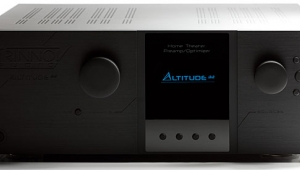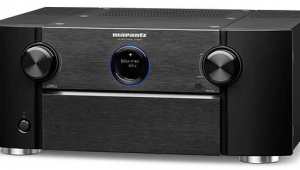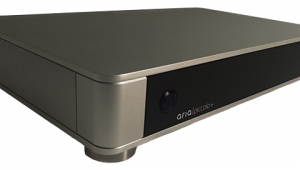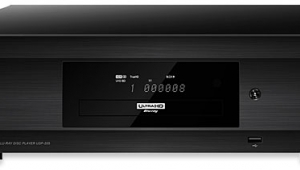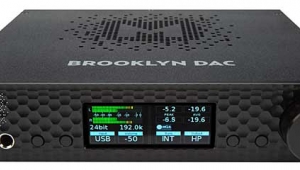| Columns Retired Columns & Blogs |
Music in the Round #15 Page 2
But subwoofers were not invented to reproduce recordings of the solo violin. Regardless of the number of voices and instruments, real and otherwise, that were playing, the bass on the Polyphonic Spree's newly EQ'd Together We're Heavy (DVD-Audio, DTS Entertainment 69286-011189-9-1) was now nimble, and defined in ways I had not suspected. Electric guitar and bass on B.B. King and Eric Clapton's Riding with the King (DVD-A, Reprise 47612-9) had a powerful kick that remained focused both tonally and spatially. Organ-pedal notes were now tubey and reedy, with discernible fundamentals, even when played at high levels. The sounds of large orchestras and choruses opened up, and, much as with solo instruments, seemed to now inhabit realistic ambiences without blending into them.
It was fascinating to compare two new recordings of Biber's Missa Christi Resugentis. Without the Velodyne SMS-1, the New York Collegium, led by Andrew Parrot (CD, Kleos KL5135), was full, but the inner voices were sometimes obscured by reverberation. Conversely, the English Consort, led by Andrew Manze (CD, Harmonia Mundi HMU 807397), was brilliant, but voices and instruments were disassociated from each other, spread as they were around the room. Cleansed by the SMS-1's EQ, both began to sound as if their respective engineers had earned their pay. The Parrot recording retained its richness, but now it was clear where and how many individual voices were placed around the front of the large, reverberant venue. Manze's musicians gained presence and coalesced into a performing ensemble even as they were arrayed in front, at the side, or behind in a very open space. The warmth and richness of the Parrot performance and the fire and brilliance of the Manze performance were now clearly distinguishable.
When great demands were made of the sub, as in Nikolaus Harnoncourt and the Vienna Philharmonic's recording of the Verdi Requiem (SACD, RCA Red Seal 61244-2), the effect was exhilarating. In the Dies Irae, the timpani, just right of center, were full and defined, but the slam of the bass drum over to the left almost knocked me out of my seat. Follow that up with the antiphonal brass of the Tuba mirum and the rest of the Requiem's dynamic extremes, and the value of Velodyne's SMS-1 was beyond question. Of course, Bruce Hall pointed out that building the EQ into the woofer, as in Velodyne's DD series, keeps your demands from exceeding the physical limits of the woofer. But if your sub has been well-chosen for your system, your room, and your taste, that should not be a big problem, especially if it's servo-controlled, as is my Paradigm Servo-15. In his review of the DD-18, Larry Greenhill said, "while other new subwoofers...may cost less, none offers all of the DD-18's features." With the addition of the Velodyne SMS-1, yours can.
Finally, while in the past I've advocated running the main left, right, and center speakers full-range, I'm changing my view. Whether running two, three, four, or five channels, the overall musical balance is superior with all the low bass running through the sub and the SMS-1, as that part of the response is flat. Until now, I have not even felt much need for a subwoofer in my New York City system with either the Revel Studio or the B&W 802D speakers. Even systems based on such large speakers should greatly benefit from the addition of an SMS-1 and subwoofer—not to extend in-room frequency response, but to linearize and flatten the bass, something that's nearly impossible to accomplish without sacrificing these speakers' overall balance and imaging capabilities. Gotta try that!
Linn Chakra power amplifiers
High-end power amplifiers are big, heavy, and run hot, right? Of course they are, if you build them using traditional technology. With the demand for ever-higher output wattages in ever more channels, we've seen more and more amp makers seduced by the appeal of high-efficiency switching designs. The Bel Canto eVo monoblocks that power my main system are outstanding examples of the success of this approach; the compact eVo4 and eVo6 remain cool even when bridged to pour gobs of power into the system. The efficiency of their class-T outputs makes possible smaller heatsinks and less demand on the power supply.

But let's take another look inside traditional amps. Isn't more and more of the real estate occupied by the power supply? Classé's Omicron, which dwarfs the eVo, has toroidal transformers that could be used as boat anchors. What if efforts were focused on increasing the efficiency of the power supplies to reduce bulk and heat while retaining the time-honored linear audio circuits? This is exactly what Linn Electronics did so successfully a few years back with the Klimax amps. Jonathan Scull waxed eloquent about the Linn 500 Solo in the October 1999 Stereophile, and I've heard them in his system so many times that I can confirm that he spoke the truth.
Linn's new Chakra series of power amps has been trickled down from the Klimax. Not only do the Chakras have highly efficient switching power supplies, they also use a monolithic amplifier module that handles all low-level signals all the time, but calls on discrete, external power stages when required. This means that the heat developed by those stages is minimized; they time-share the duty with the cool-running IC. The Chakras come in varieties of two through seven channels per chassis, with apparent claimed outputs of 100Wpc or 200Wpc. I say apparent because those are the ratings into 4 ohms, not the more usual 8 ohms. Linn's ratings may actually be more revealing—a 4 ohm rating is more dependent on an amp's current capacity—but it's also somewhat disingenuous. First, the Wpc number looks larger in superficial comparisons, and second, more speakers are rated close to 8 ohms than to 4. The 100Wpc and 200Wpc Chakra models can thus also be described as putting out 56Wpc and 111Wpc into 8 ohms, respectively. I thought that the 200/111Wpc (4/8 ohms) would have been more suitable for my systems; instead, Linn sent me a three-channel C3100 and a four-channel C4100, both rated at 100/56Wpc and each weighing a bit over 13 lbs.

The Chakras' svelte, sexy appearance, low weight, and relative small size make them ideal for multichannel systems, but I couldn't resist immediately hooking them up to the current residents of my 5000ft3 main listening room, the B&W 802Ds. "No fair!," you say. You're right. While sweet and clean at background levels, the Chakras' 56Wpc made wimps out of the big B&Ws if I tried anything approaching live listening levels. Because I had amp channels to spare, I then tried biamping the B&Ws. The result was somewhat better but still suboptimal.
Things were surprisingly different in my weekend Connecticut system. After the first Chakra experience in New York, my expectations were not high, even with the smaller Paradigm Studio/60 v.3s in their 1800ft3 room. With the four-channel C4100 running the main L/R speakers and the three-channel C3100 driving the center and surrounds, the sound was big and open from two- and multichannel sources. I ran them through my gantlet of first tests: DMP's Multichannel SACD Sampler and DTS's Sampler #9. The potency of these small amps knocked me out. Whether I ran the front channels full-range, or bass-managed by the Outlaw ICBM Bass Manager and Velodyne SMS-1, their balance and fullness were impressive, even at quite high playback levels. Of course, there was more extended and palpable bass with the Paradigm Servo-15 subwoofer, but this is true even with much bigger amps; it's just that the sub is better at this than the Studio/60 v.3s.
To hear how the Chakras would handle electric and acoustic bass, I then played Clapton and King's Riding with the King, as well as Buster Williams playing piccolo bass on his Griot Liberte (SACD, High Note HCD7123), both without bass management. Son of a gun! Tight, clean, and punchy, and not at the expense of any concomitant strain in the rest of the spectrum. This is important—the Chakras are among the most revealing and transparent amps I've used.
Then I played one of the delightful new Caro Mitis hybrid SACD/CDs, all of which are remarkably well recorded and mastered and available in the US from M•A Recordings. I was impressed with some literal inspiration on Oboenspitze, Vol.1, a disc of three works by Mozart for oboe performed by oboist Alexei Utkin and musicians of the Hermitage Chamber Orchestra (Caro Mitis CM 0032004). Utkin begins most of the tracks by drawing a deep breath. I had expected the prominence of those inhalations to sound too close and too hard-pointed. Not so, it turned out—within a second, as the clear, dulcet sound of the oboe introduces the ensemble, all was clean and rounded in a plausible ambience. From the charming Quintet (Utkin's transcription of String Quintet 4, K.516) and the graceful Andante (transcribed from K.315) to the brilliant and charming Oboe Concerto in C (K.314), the balances of solo oboe and supporting ensembles were natural and robust. As with the bass test discs, the Chakras related all the details of the music with a stability and transparency of soundstage that were notable.
I also luxuriated in the sound of two new choral SACDs that capitalized on the ability of the Linn Chakras to reveal an ensemble's inner voices and threads. The complex harmonies on Sea Change, a disc of the choral music of Richard Rodney Bennett performed by the Cambridge Singers led by John Rutter (Collegium CSACD 901), were recorded closely. Through the Green Fuse, a varied collection of traditional and contemporary choral arrangements sung by the Conspirare Company of Voices led by Craig Hella Johnson (Clarion CLR915CD, available from Collegium), was more distantly recorded in a more resonant space, which was generally consonant with its harmonies. Both were thrillingly detailed via the Linn amps at any reasonable level.
The Chakras' abilities were also demonstrated, appropriately, with an outstanding new SACD of Linn's own—Clio Gould leading the Scottish Ensemble in three early masterpieces by Benjamin Britten: Les Illuminations, Variations on a Theme of Frank Bridge, and the Serenade for Tenor, Horn, and Strings (Linn CKD 226). From the beginning of Les Illuminations to the serene Epilogue of the Serenade, these are brilliant treatments of these works. They may clock in fast compared with other versions, but there's no sense of haste, only of purpose. As proof of the performance of both the music and the amps, listen to the balance of the horn and bass fiddles in the Elegy of the Serenade—and, even more impressive, the clarity of Toby Spence's tenor and the warmth and attack of Martin Owens' horn, especially in the Dirge.
Did I need more power? Not really. I biamped the main L/R Paradigm Studio/60 v.3s, drove them full-range, and got a smidgen more oomph—but the results were even better with bass management and only one Chakra channel per speaker. Clearly, these 56Wpc amps are not for head-bangers, unless said bangers possess speakers much more efficient than mine. The 111Wpc models might do a bit better (almost 3dB at 8 ohms), but appropriate bass management will make such concerns irrelevant. Moreover, the Chakra was a near-perfect match for the 4 ohm Magnepan MGMC1 speakers I often use as surrounds. I can only imagine how sweetly a five-channel Chakra C5100 might sing through the Magnepan home-theater speaker system I reviewed in December 2003.
In sum, the Linn Chakra amplifiers are ideal for multichannel systems. They come with almost any useful number of channels on a single, compact, cool-running chassis, and, with the right speakers and/or bass management, are muscular enough for music and theater. More important, few other amps, at any price or weight, can outperform them in transparency and soundstaging.
Next time in the Round
By now, I should be circumspect about predicting what will appear in the next column, but I expect to offer a new idea about room treatment and EQ, and review yet another universal disc player. The only things certain are more mini-reviews of new multichannel recordings (see sidebar).
- Log in or register to post comments


